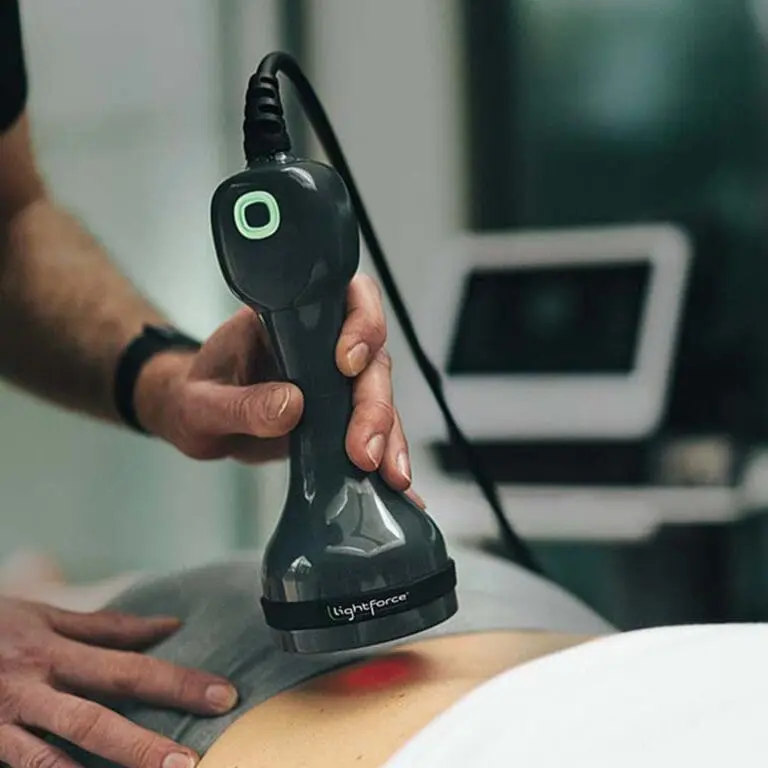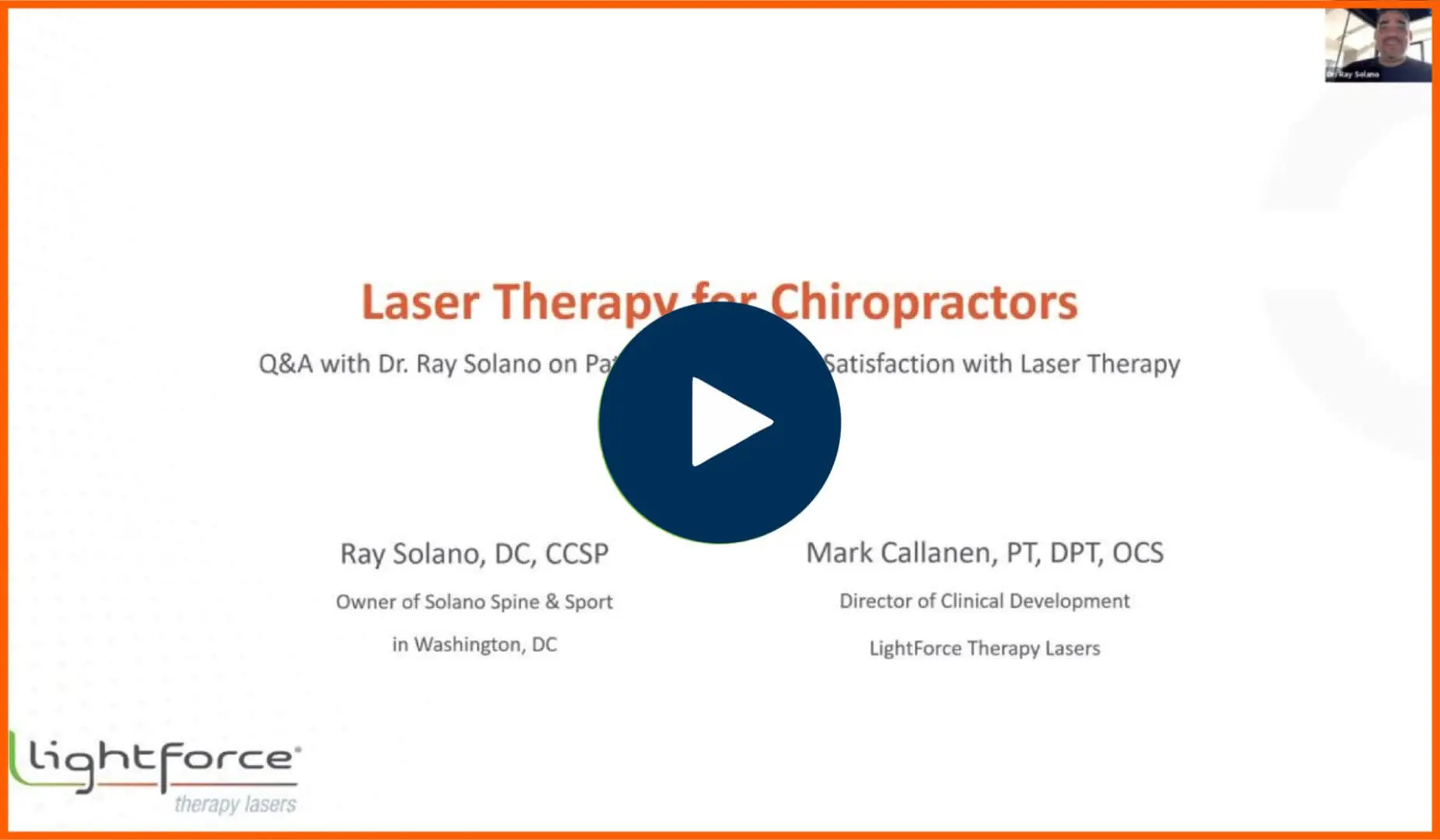
CHIROPRACTIC LASER THERAPY
IMPROVE HEALTH
Better outcomes with tangible results.
Elevating the health and wellness of the community is a primary mission of the chiropractic profession. Practitioners pursuing patient-centered, evidence-based care should consider laser therapy as a proven, non-invasive choice for addressing pain.
Class IV laser therapy, via photobiomodulation, has been shown in multiple studies to quickly reduce pain and help injured tissue move through the stages of healing by stimulating mitochondrial activity. This powerful tool can be used within a comprehensive plan of care to help treat many diagnoses common to chiropractic practices. As a cash-based modality, a well-run chiropractic laser therapy program will not only improve patient outcomes, it can significantly improve clinic income.
CLINICALLY USED FOR:
- Neck and back pain (chronic and acute)
- Muscle strain/ pain
- Myofascial pain
- OA related pain
- TMJ pain
- Headaches
- Joint swelling
- Tendinopathy
- Neuropathy
- Plantar fasciitis
- Achilles tendon pathology
- DOMS (Delayed Onset Muscle Soreness)
- Lymphedema

OUTCOMES = INCOME
“We’ve been treating everyone from geriatric patients to athletes. And we’ve seen people leave the same day with exponentially less pain and overall faster recovery times. The laser has also given us an advantage in the community by having a cutting edge modality that’s not offered by other physicians.”
Ryan Goodman, D.C., CCSP
5 Things Every Chiropractor Should Ask Before Buying a Therapeutic Laser
Looking to add a chiropractic laser for pain treatment?
If you are a chiropractor and thinking of adding Class IV laser therapy to your practice, there are a few questions you should ask before you make a purchase. You should be purchasing more than a laser for pain – but a total solution for your practice. Here are 5 questions you should ask your sales representative before you buy:
1 Implementation:
Your new chiropractic laser must be thoroughly understood. Many companies say they provide implementation solutions for your practice but take the time to dig deeper to understand the details of the support materials they provide. Does the implementation program help educate the staff and clients alike? What components are really included in the program? Some companies offer comprehensive marketing toolkits that include both staff and patient education tools. The more comprehensive toolkits should include client education videos, presentations, ads, banners, training videos, promotional materials for the office, website resources and marketing tips.
2 Downtime:
When adding any type of capital equipment to your practice there is always the possibility that the chiropractic laser will require repair or maintenance. Ask your sales representative what happens if your chiropractic laser therapy equipment experiences a failure. Will they send you a loaner unit? How long will it take to repair your unit? The answer you should get is that the company will deliver a loaner system to you overnight to ensure you don’t go a day without your therapy laser.
3 On-Going Chiropractic Laser Therapy Education:
Ask about what kind of educational opportunities are available after you purchase your laser therapy equipment. Some companies offer on-going seminars, webinars, users’ conferences, and special CE events. Also ask if the company you plan to work with is engaged in scientific studies – is the company continuing to educate itself too? The strong companies are constantly striving to learn and teach.
4 Clinical Support:
If a patient comes in and you are not sure how to approach their condition is there someone at the laser therapy company you can talk to? Clinical support is a must-have. Ask about who the clinical experts are on staff that will answer your questions – what are their credentials?
5 Customer Care:
Is there a dedicated customer care department? How long does it take for them to get back to you? When you are having a problem the last thing you want to do is wait. Go with a company who prides itself on outstanding customer care after the sale.
Class IV laser therapy can have a real impact on your patients and your practice. Be sure you are selecting a company who will be your laser therapy partner for the long-term.
THE SCIENCE AND EVIDENCE BACK IT
Recommended Abstracts
Low Back Pain
Effect of diode laser in the treatment of patients with nonspecific chronic low back pain: a randomized controlled trial
https://www.ncbi.nlm.nih.gov/pubmed/25141218
Joint Disorders
A systemic review of low level laser therapy with location-specific doses for pain from chronic joint disorders
https://www.ncbi.nlm.nih.gov/pubmed/12775206
Musculoskeletal Disorders
Effectiveness of high intensity laser therapy in the treatment of musculoskeletal disorders
https://www.ncbi.nlm.nih.gov/pubmed/30572425
Neck Pain
Efficacy of low-level laser therapy in the management of neck pain: a systemic review and meta-analysis of randomized placebo or active-treatment controlled trials
https://www.ncbi.nlm.nih.gov/pubmed/19913903
Neuropathy
Sensory small fiber function differentially assessed with Diode Laser (DL) Quantitative Sensory Testing (QST) in Painful Neuropathy (PN)
https://www.ncbi.nlm.nih.gov/pubmed/23433028
Plantar Fasciitis
The effect of high-intensity versus low-level therapy in the management of plantar fasciitis: a randomized clinical trial.
https://www.ncbi.nlm.nih.gov/pubmed/29627888
Subacromial Impingement Syndrome
Low-level laser and local corticosteroid injection in the treatment of subacromial impingement syndrome: a controlled clinical trial
https://www.ncbi.nlm.nih.gov/pubmed/24519921
Short-term Effects of High-Intensity Laser Therapy Versus Ultrasound Therapy in the Treatment of People With Subacromial Impingement Syndrome: A Randomized Clinical Trial
https://www.ncbi.nlm.nih.gov/pubmed/19482902
Tendinopathy
Photobiomodulation and eccentric exercise for Achilles tendinopathy: a randomized controlled trial.
https://www.ncbi.nlm.nih.gov/pubmed/26610637
Low Level Laser Treatment of Tendinopathy: A Systematic Review with Meta-analysis.
https://www.ncbi.nlm.nih.gov/pubmed/19708800
Recommended Articles


